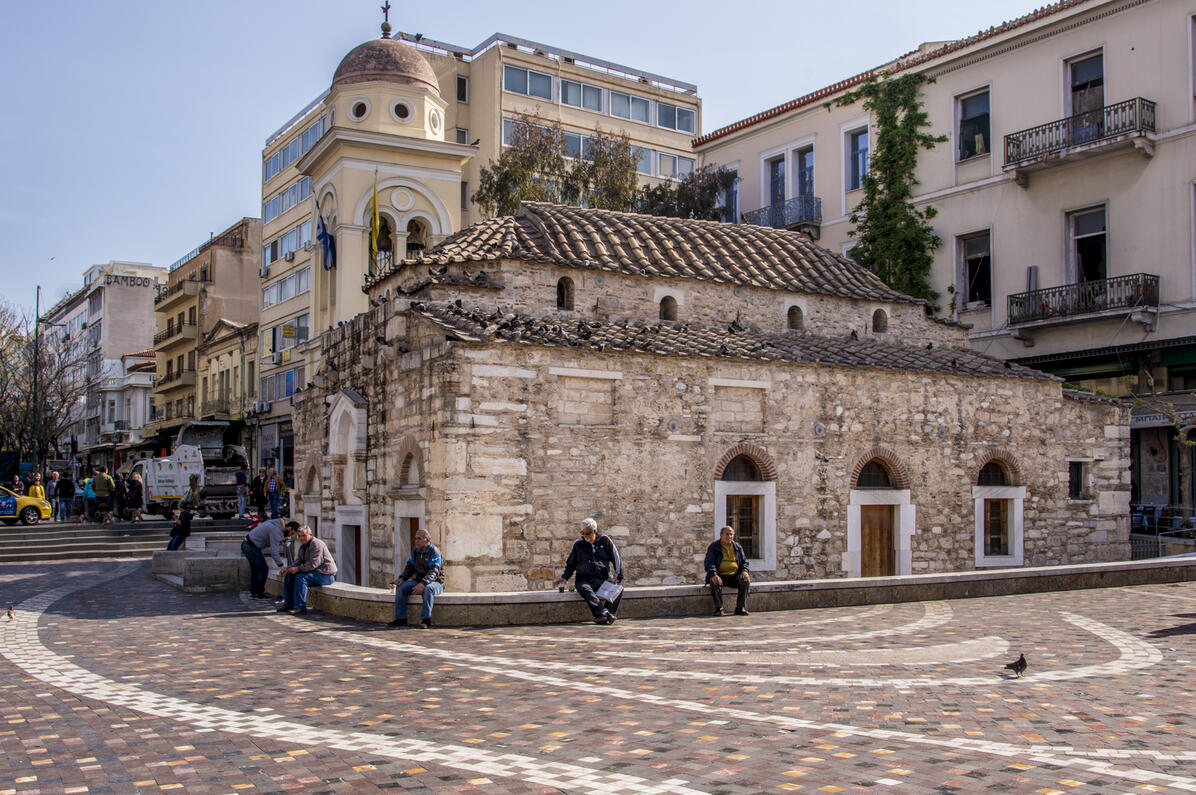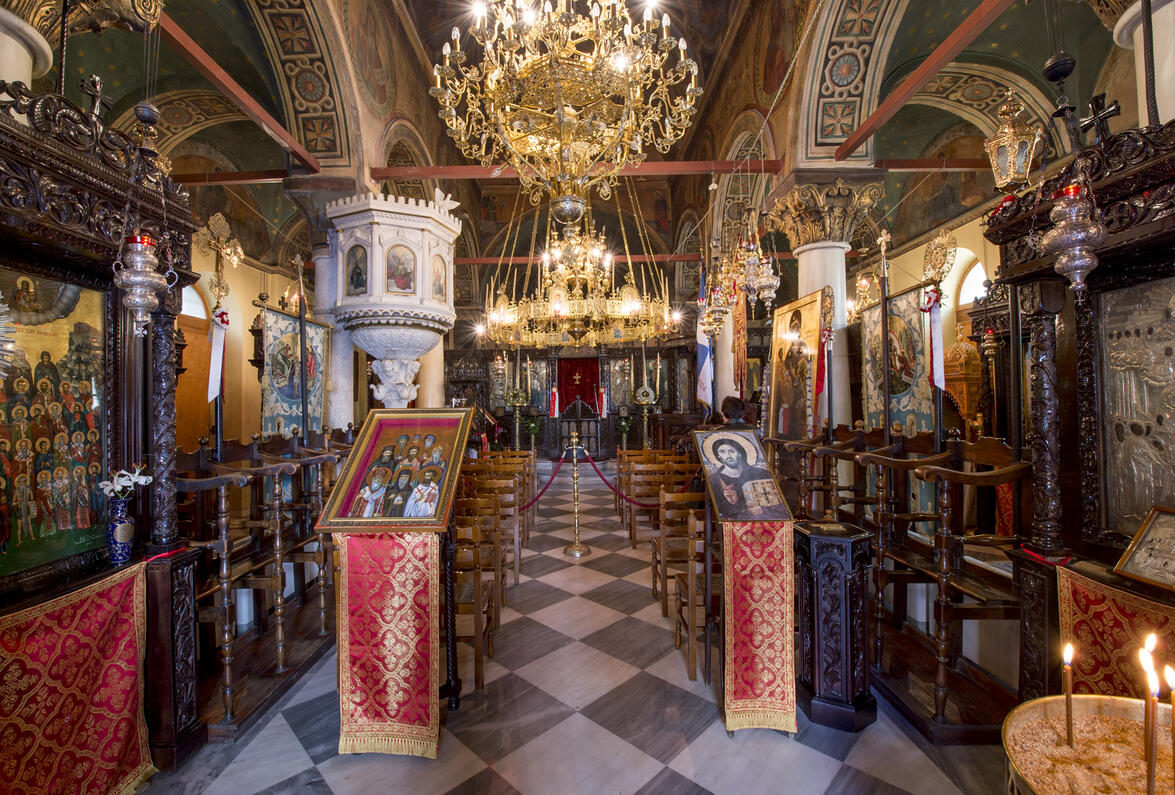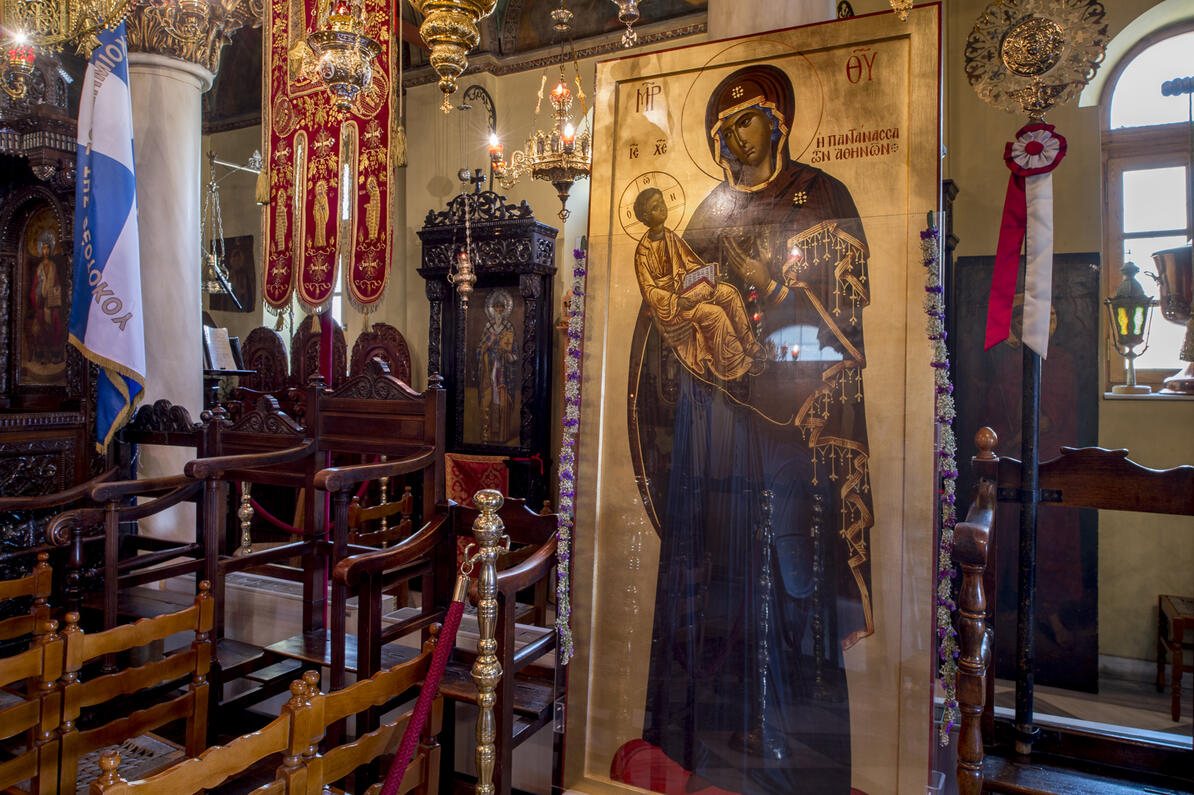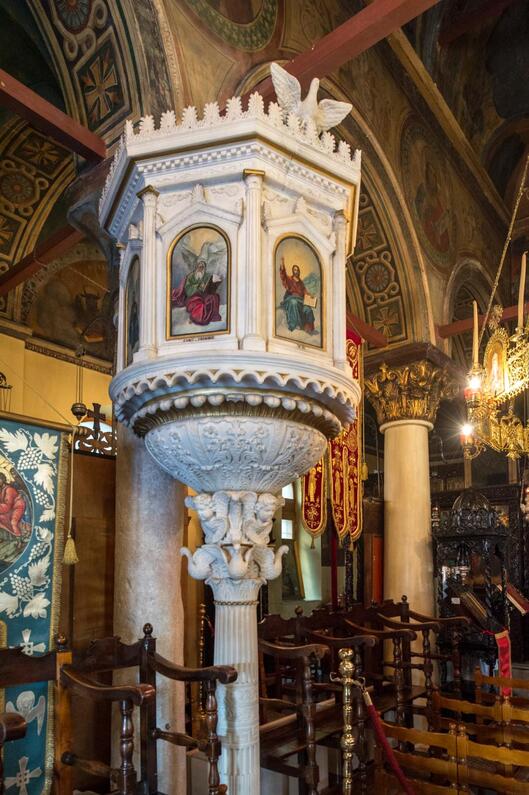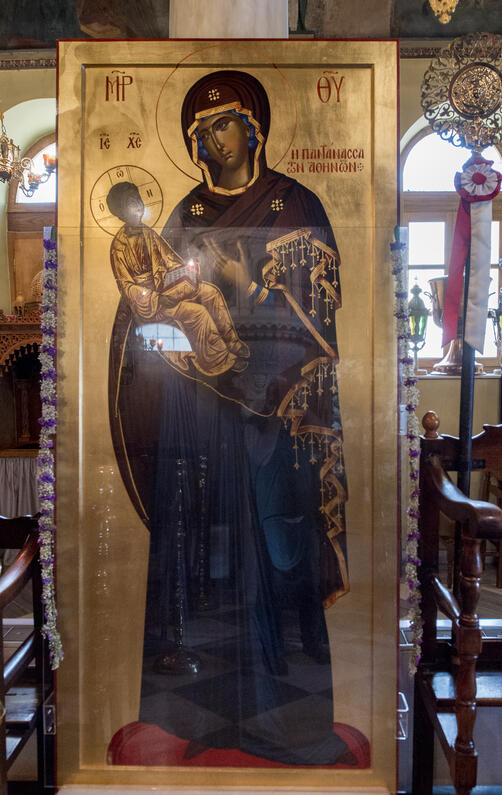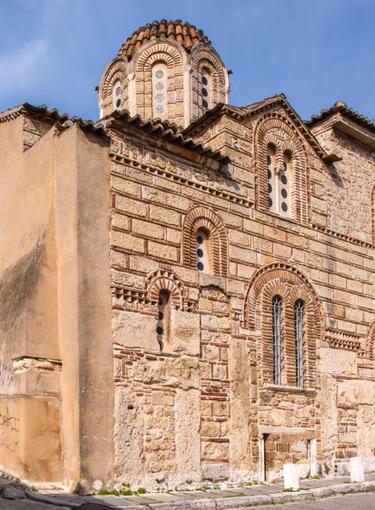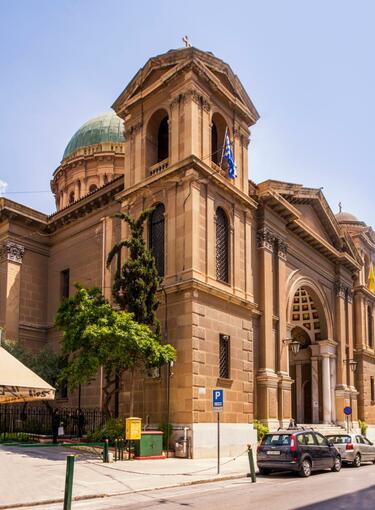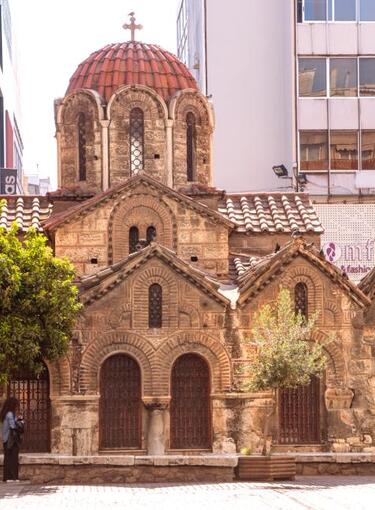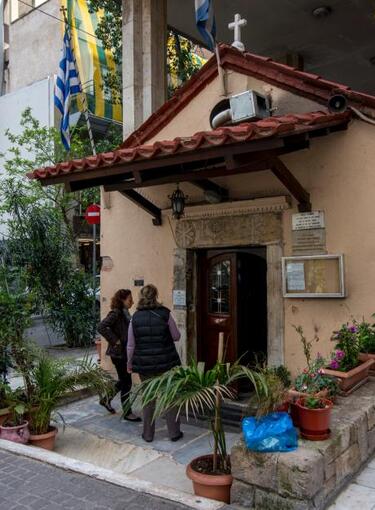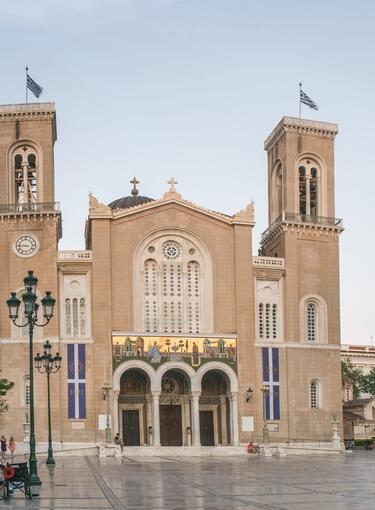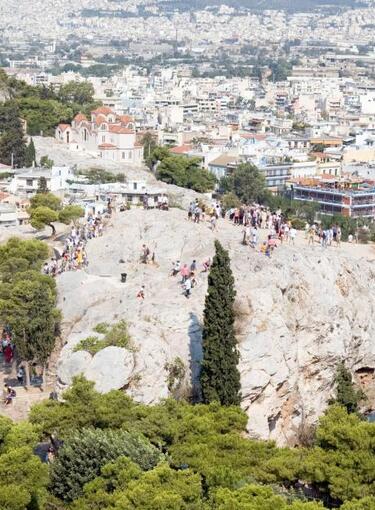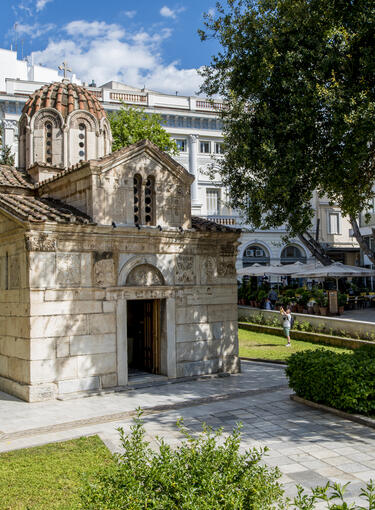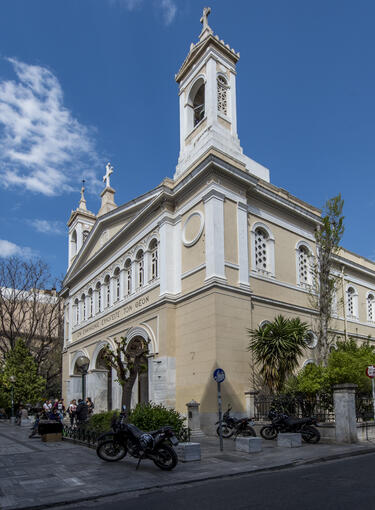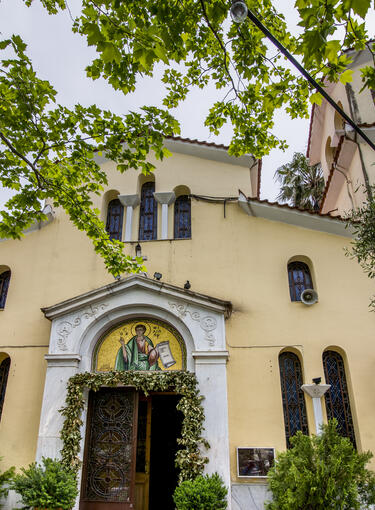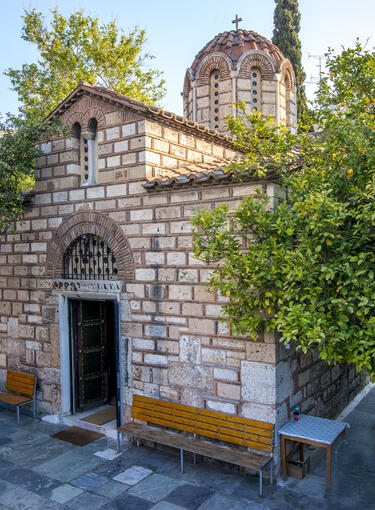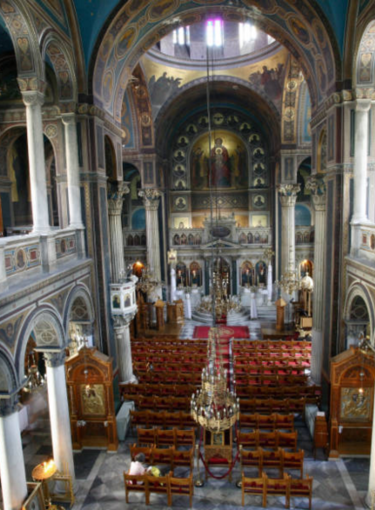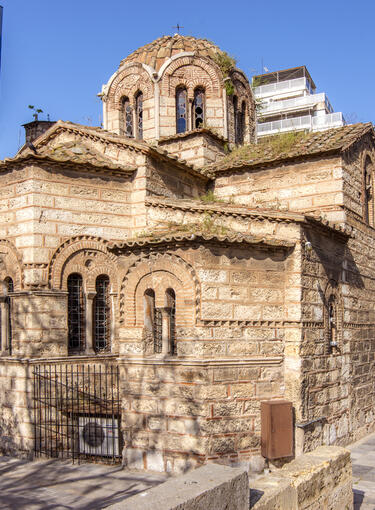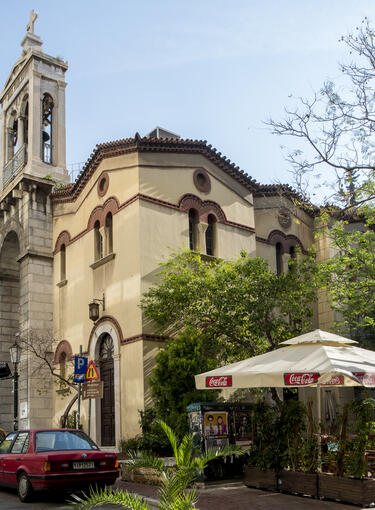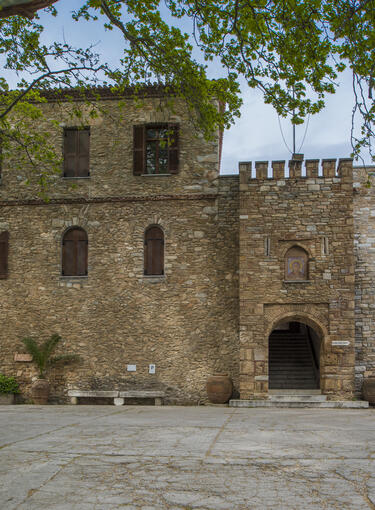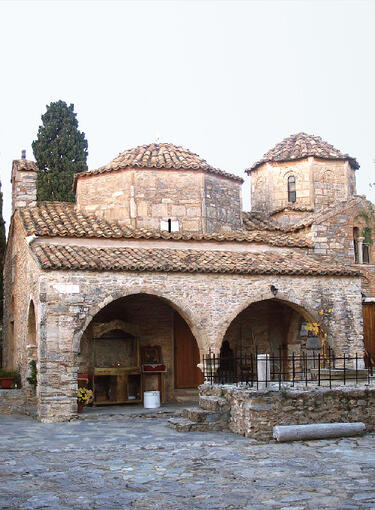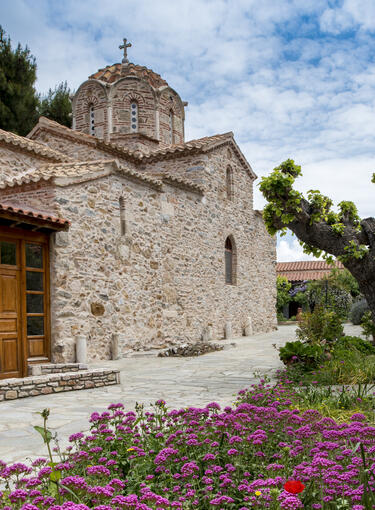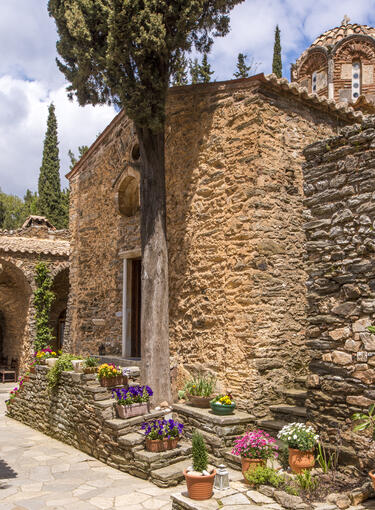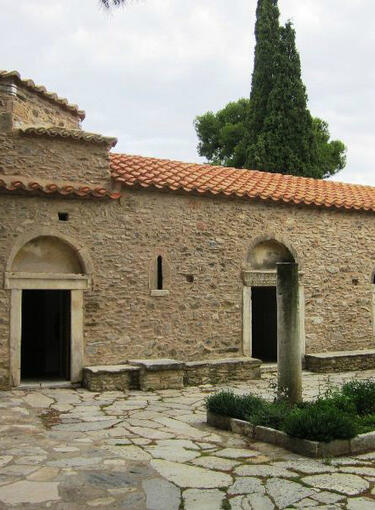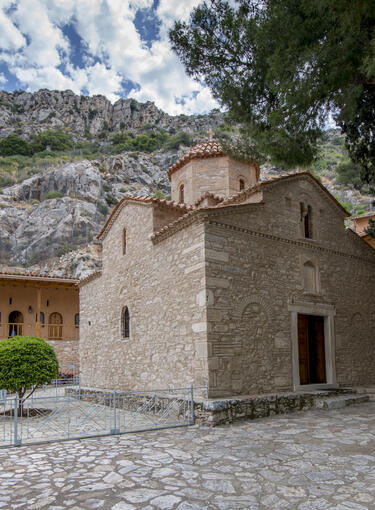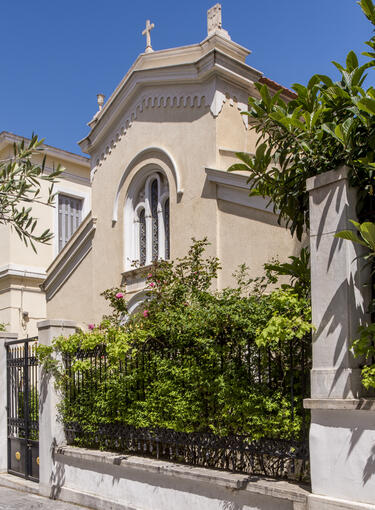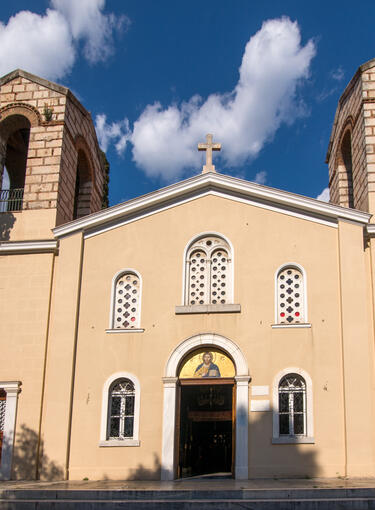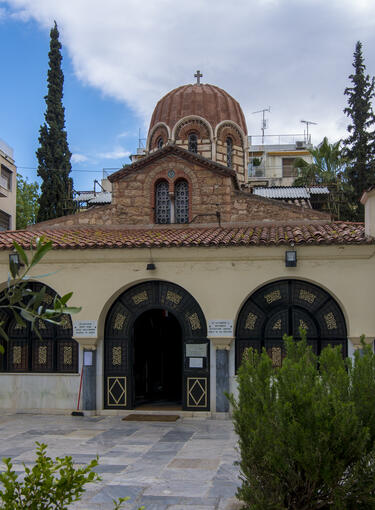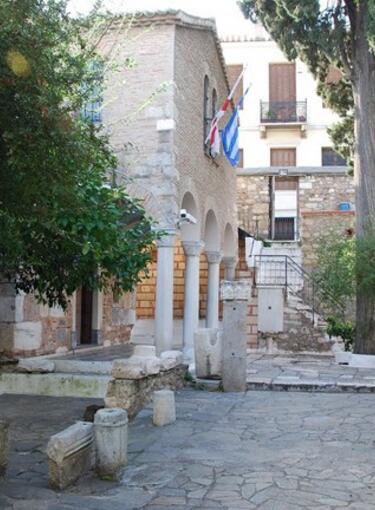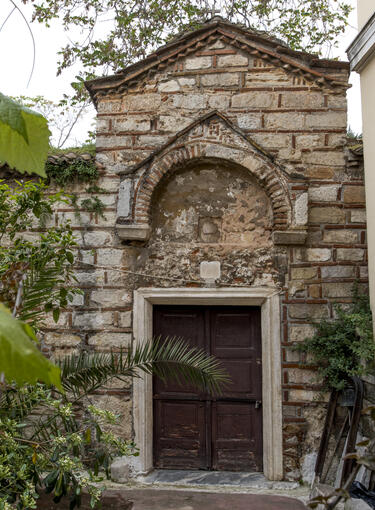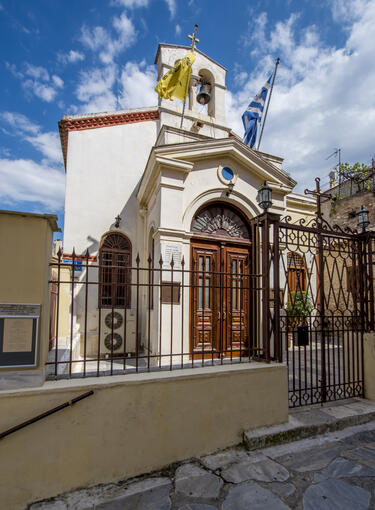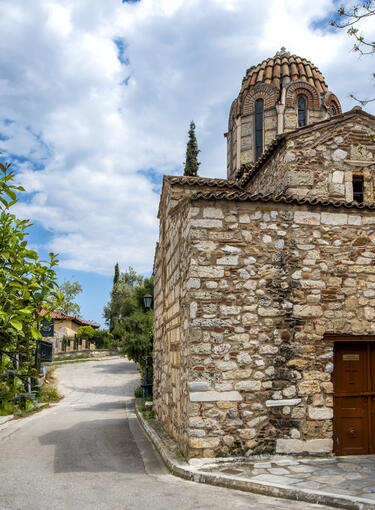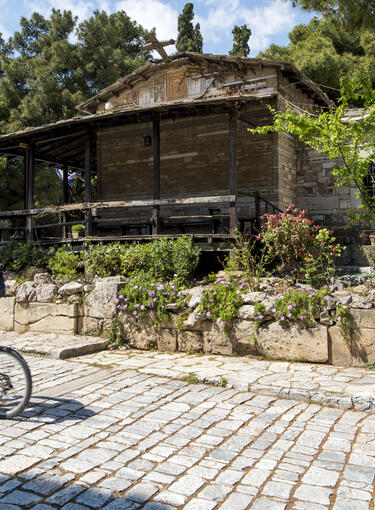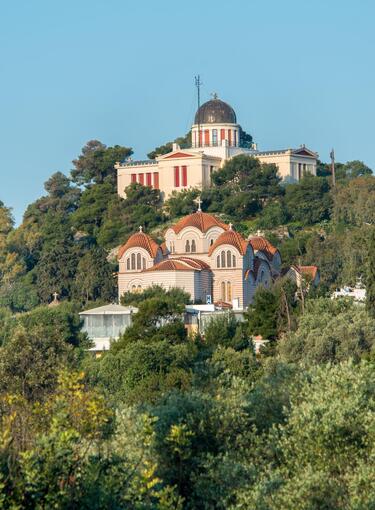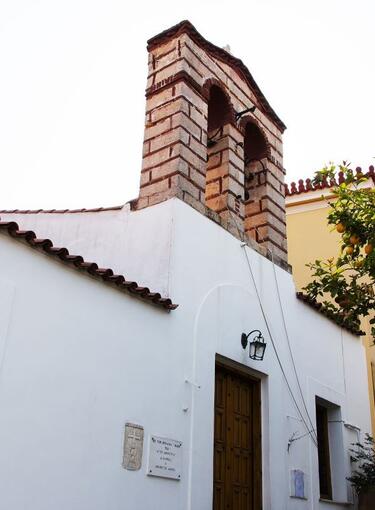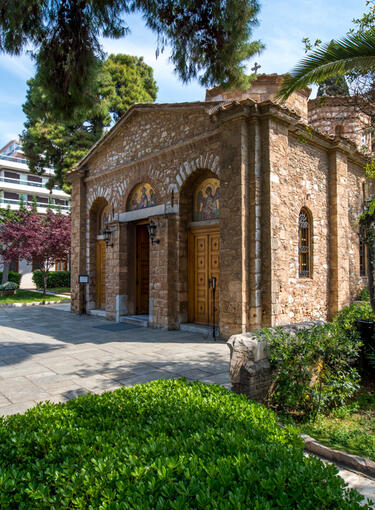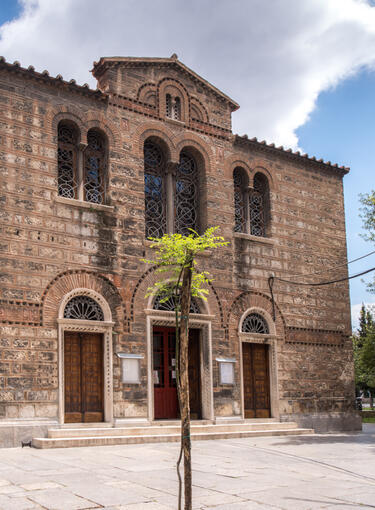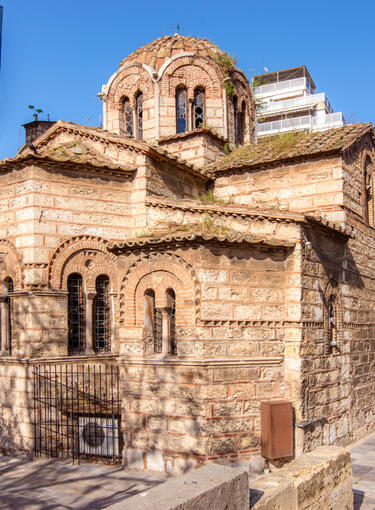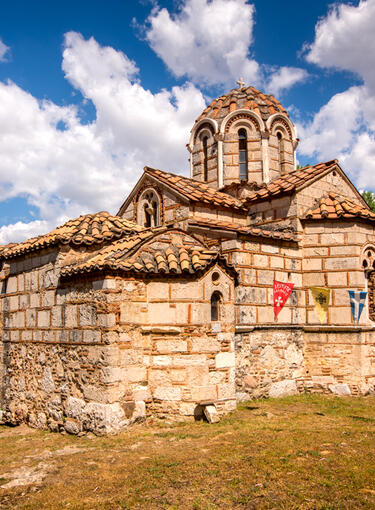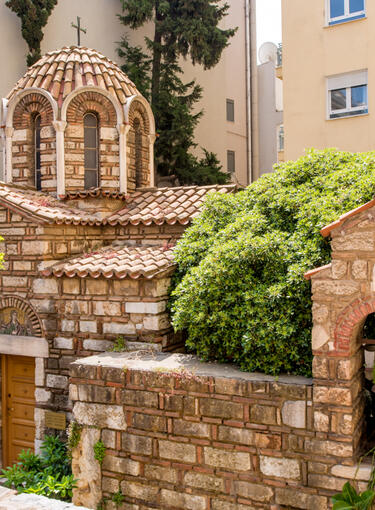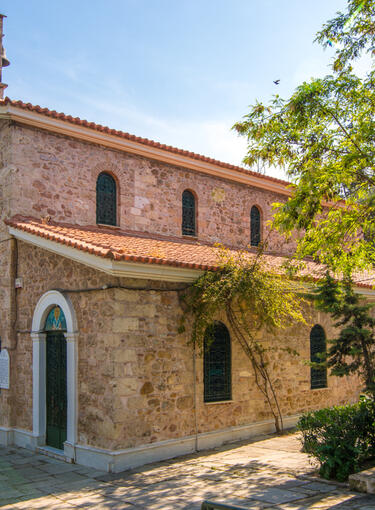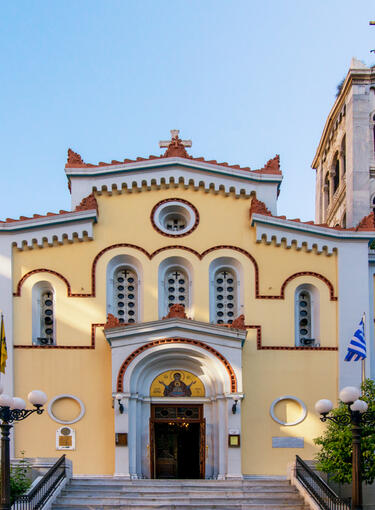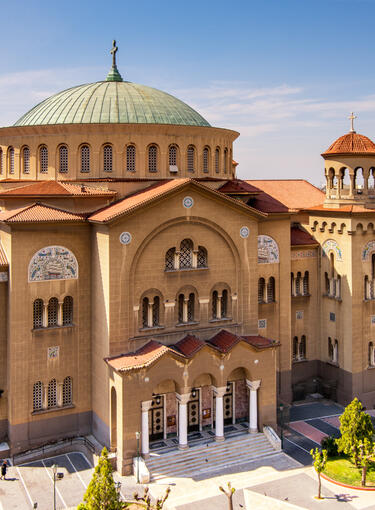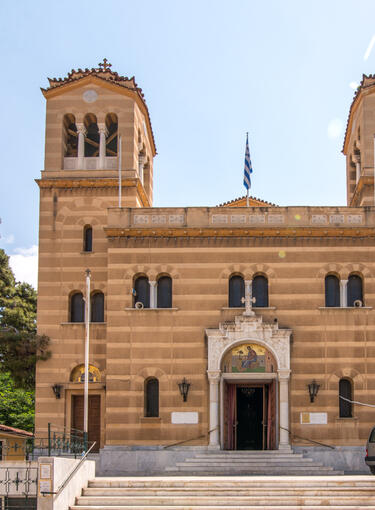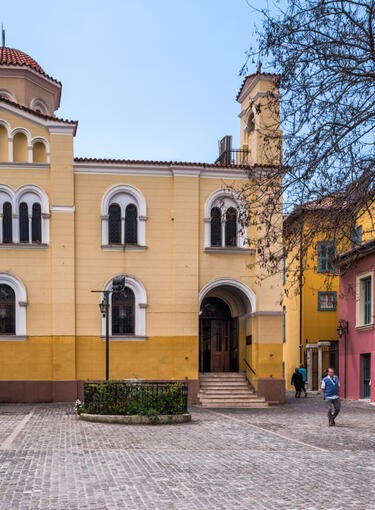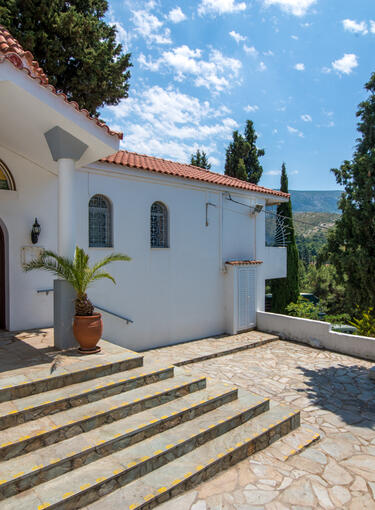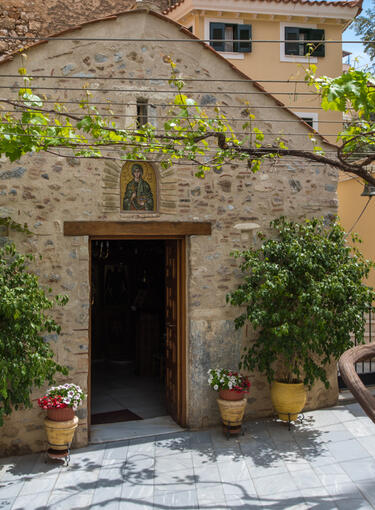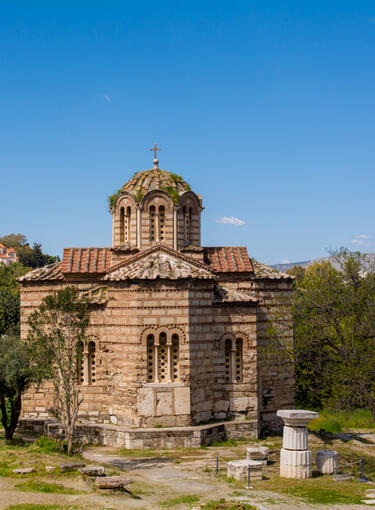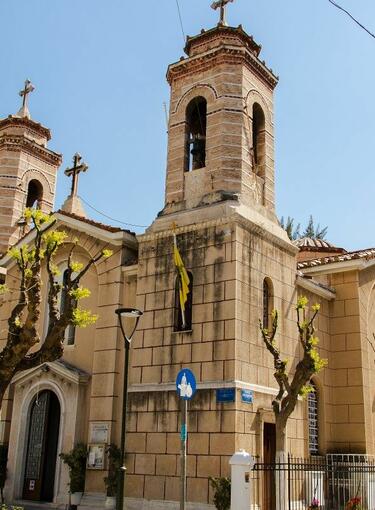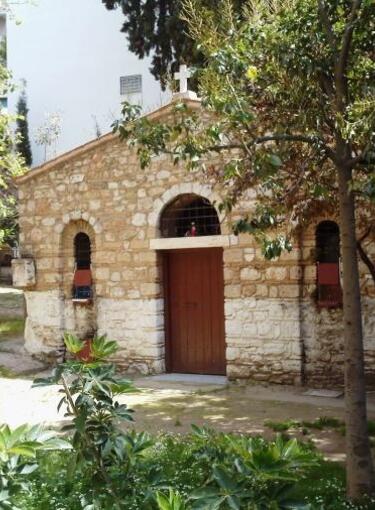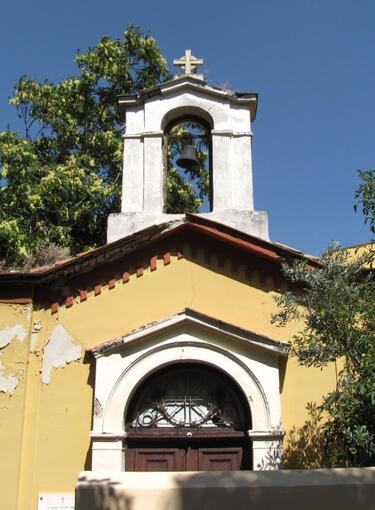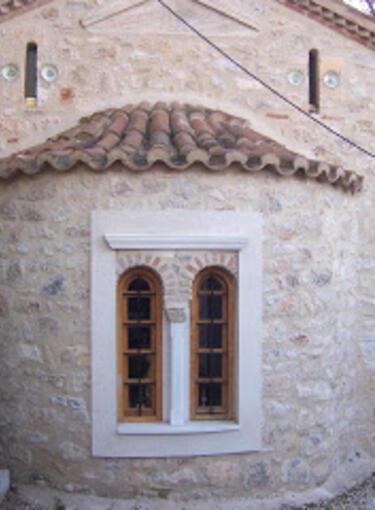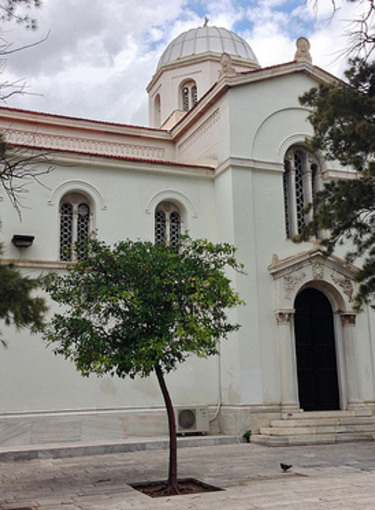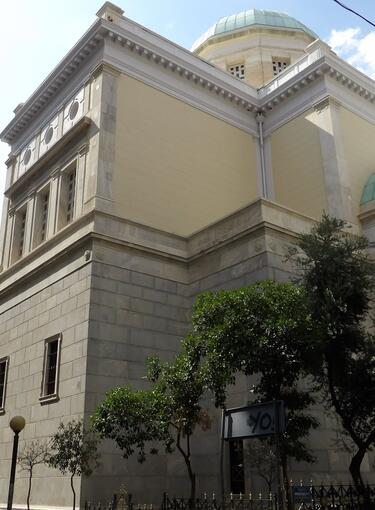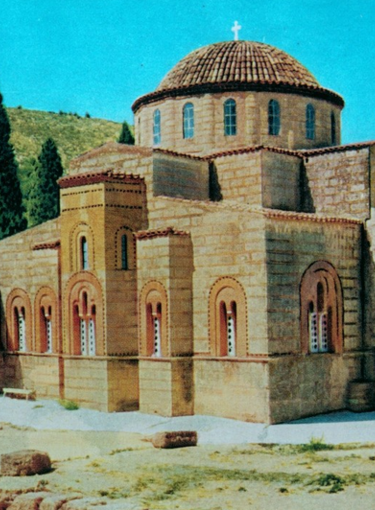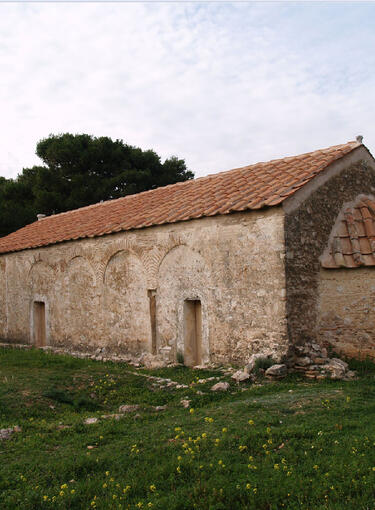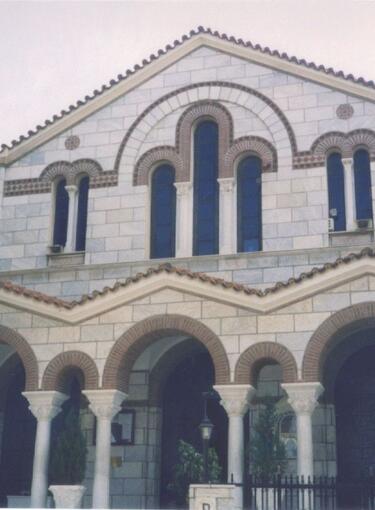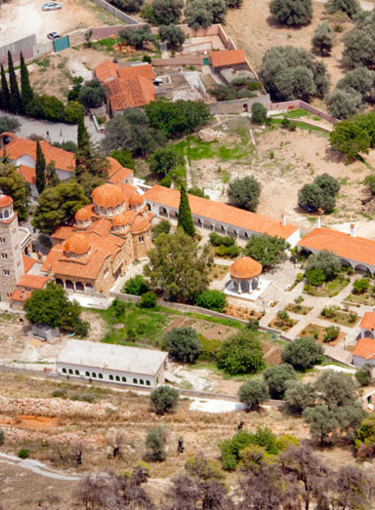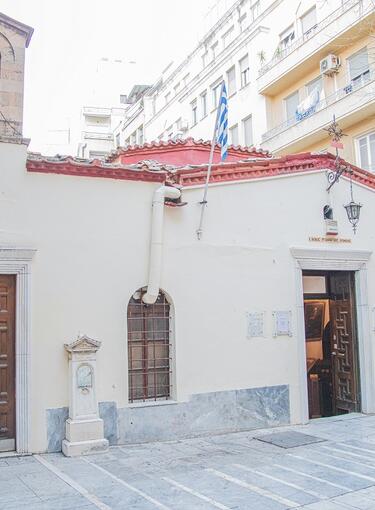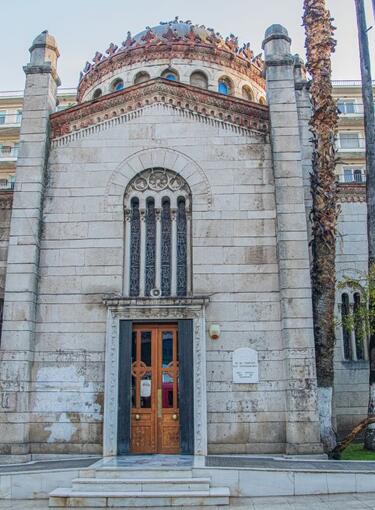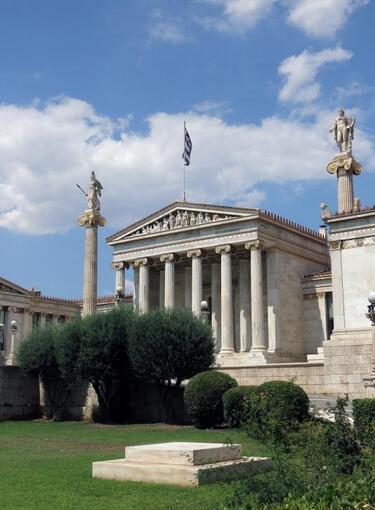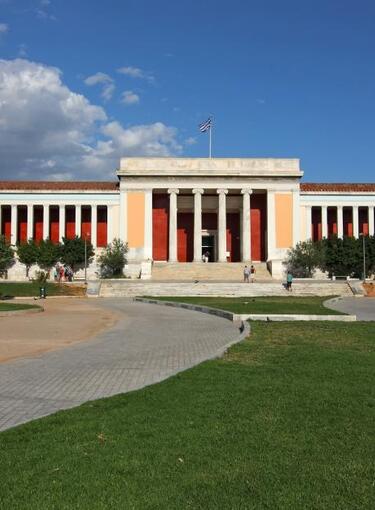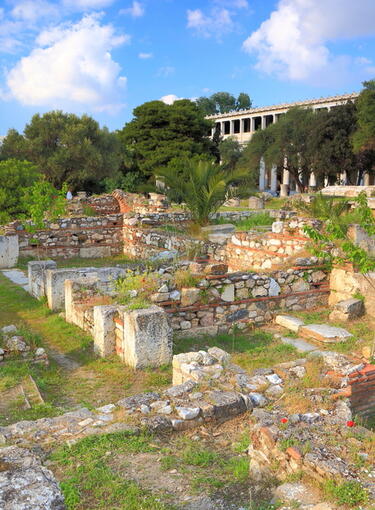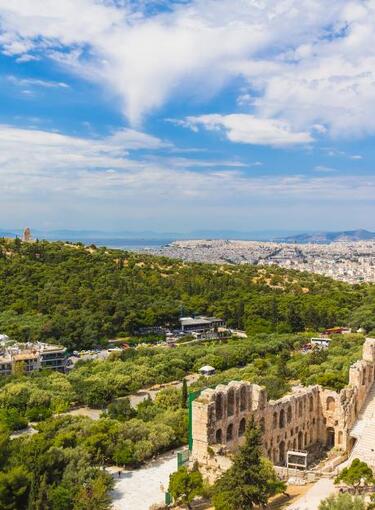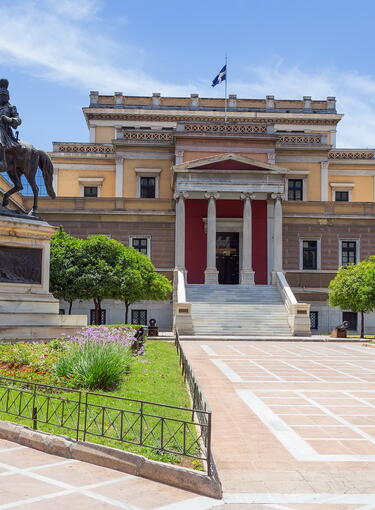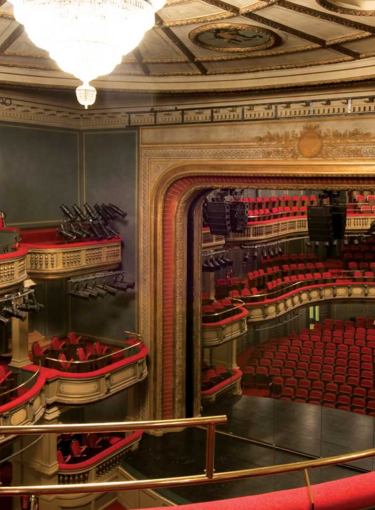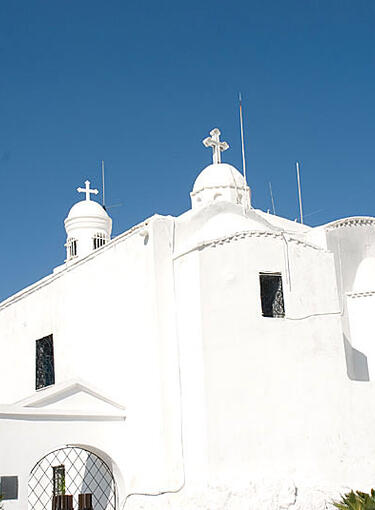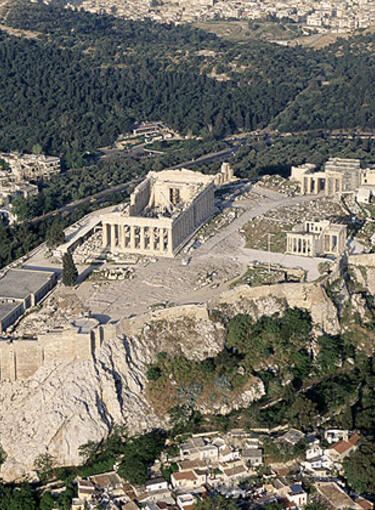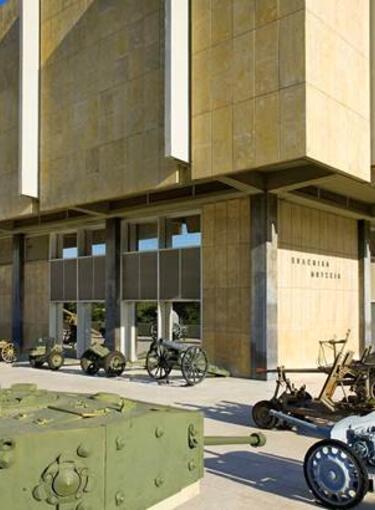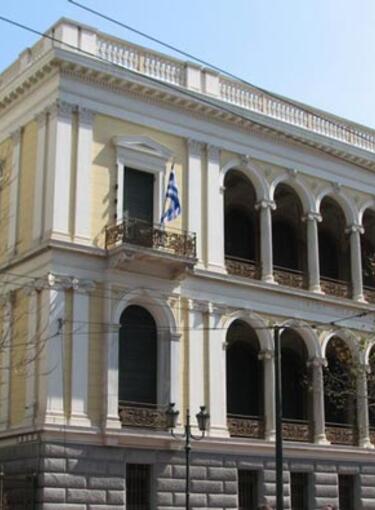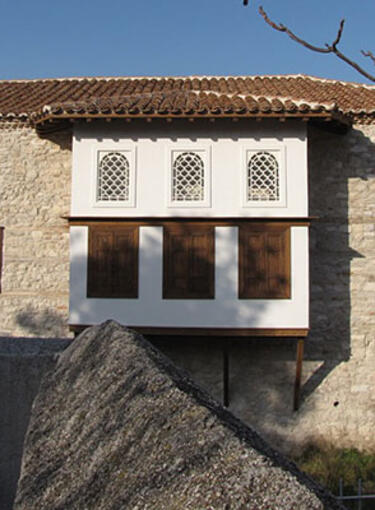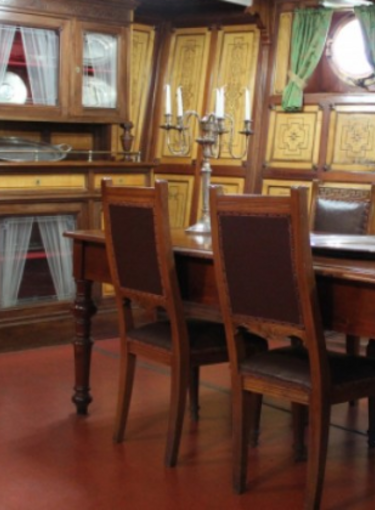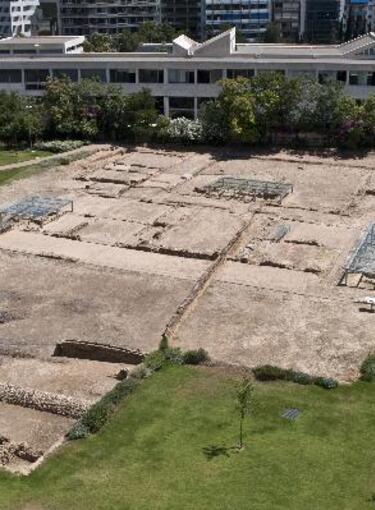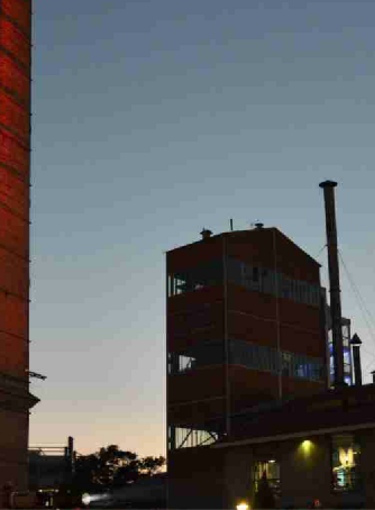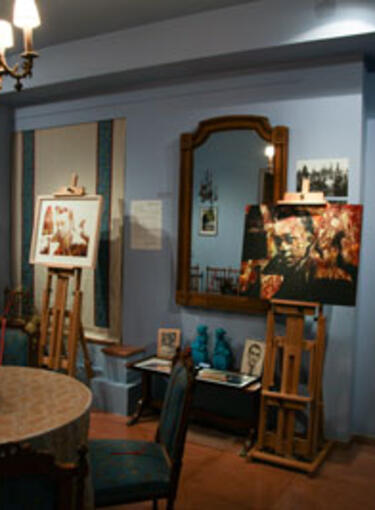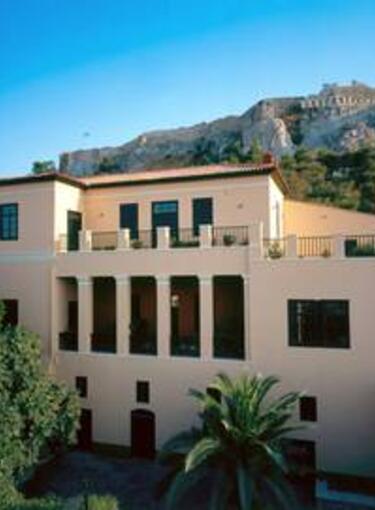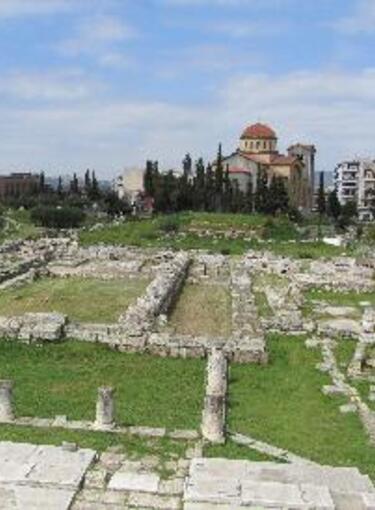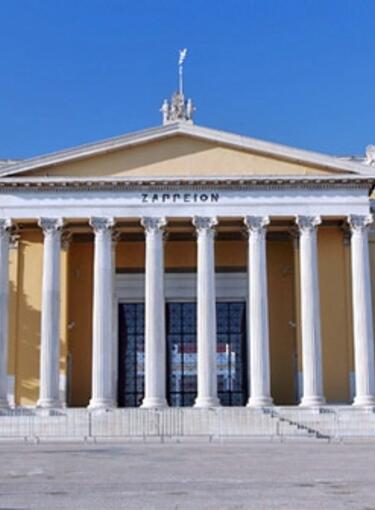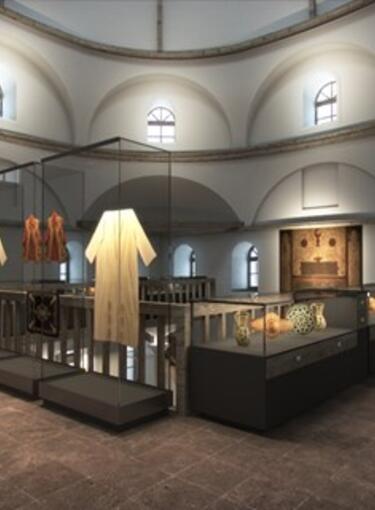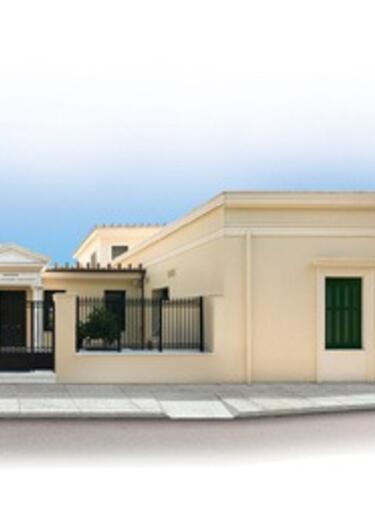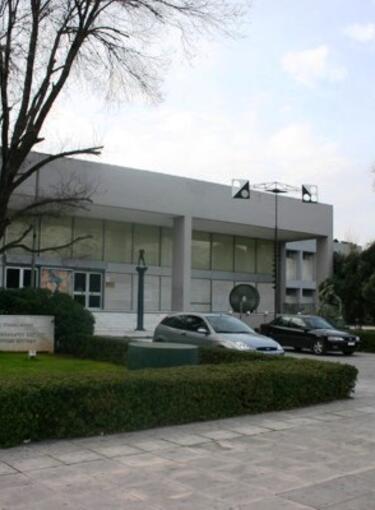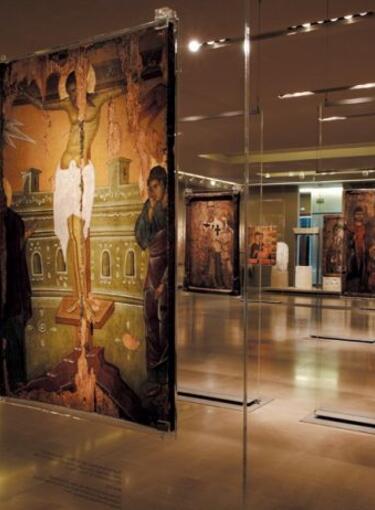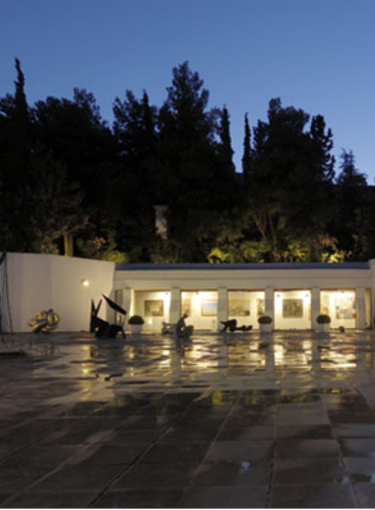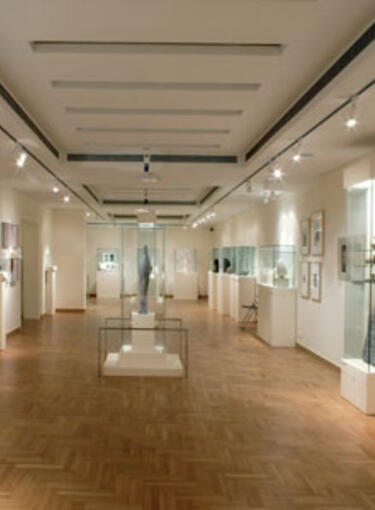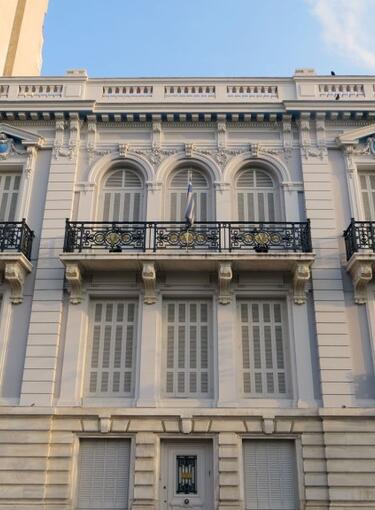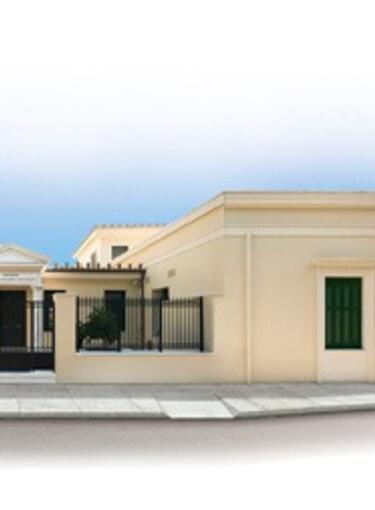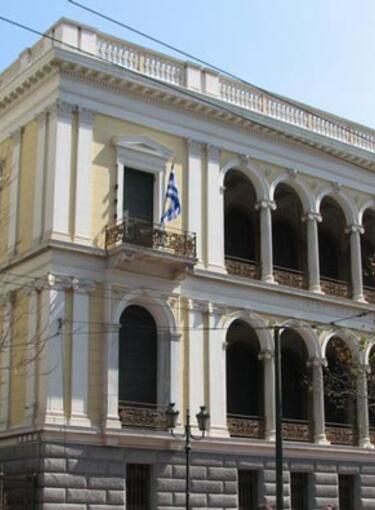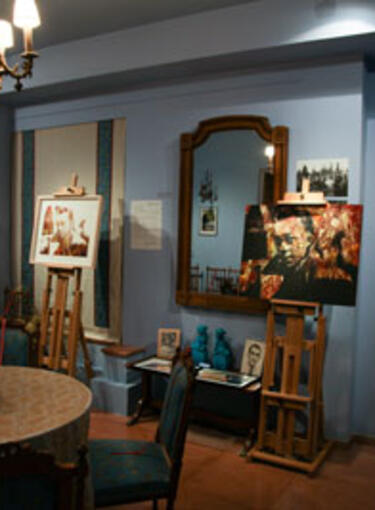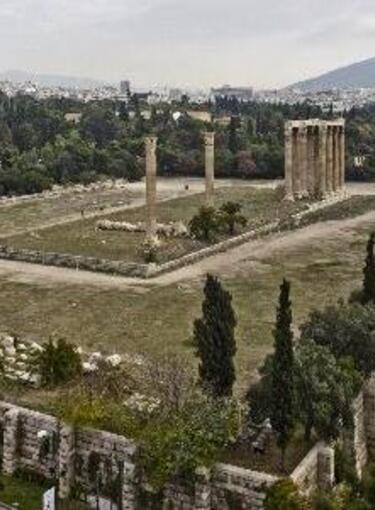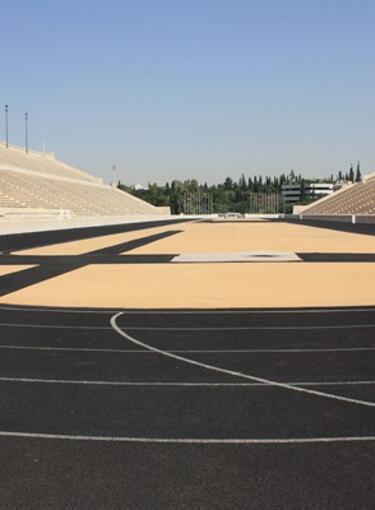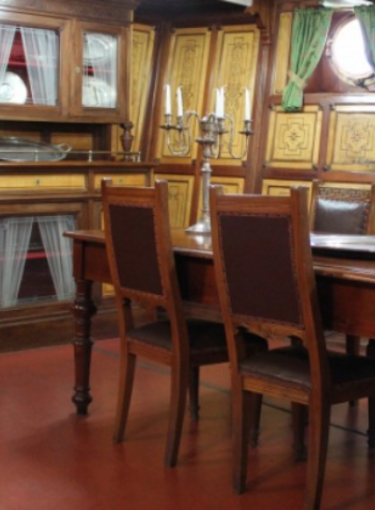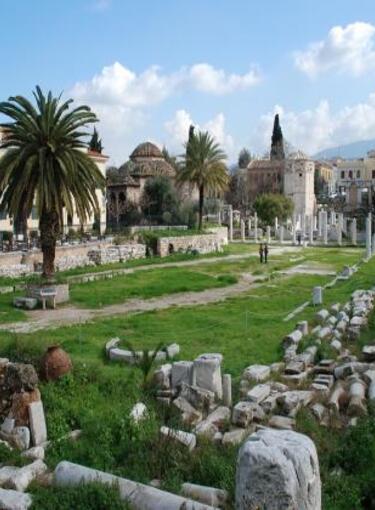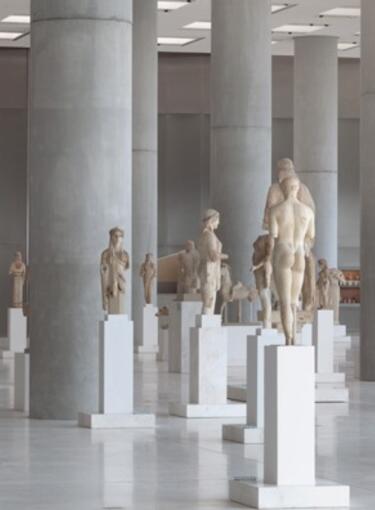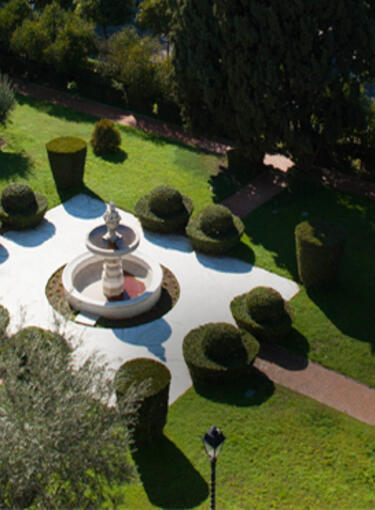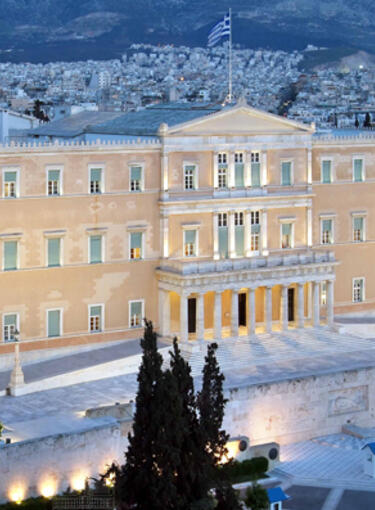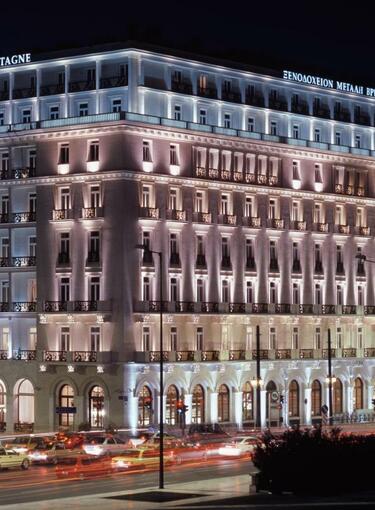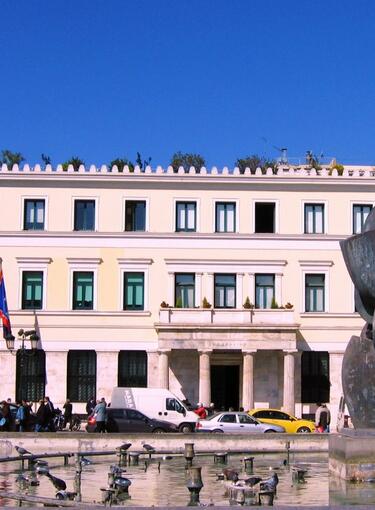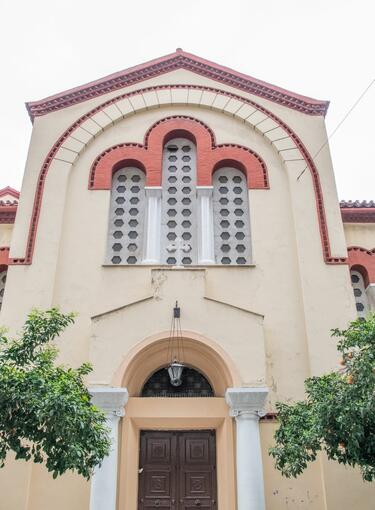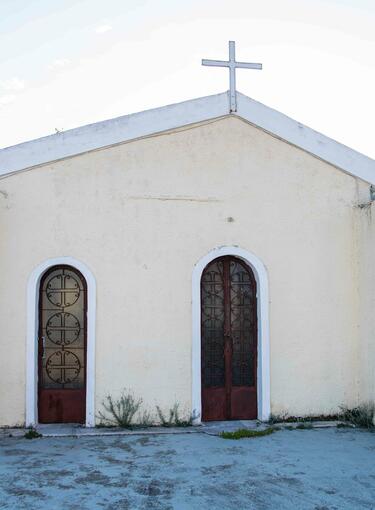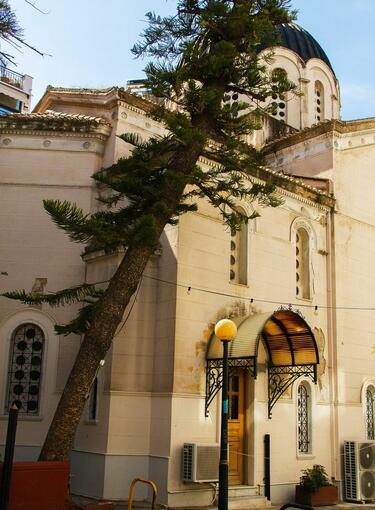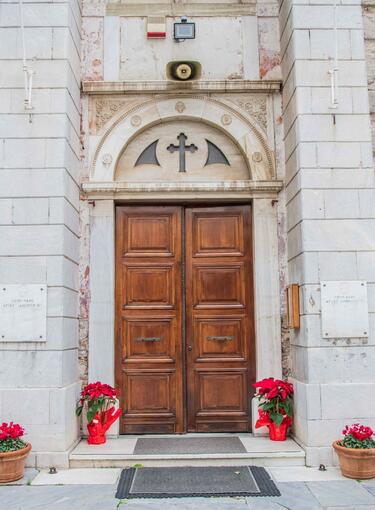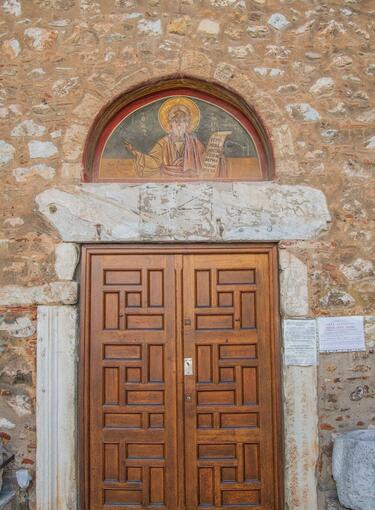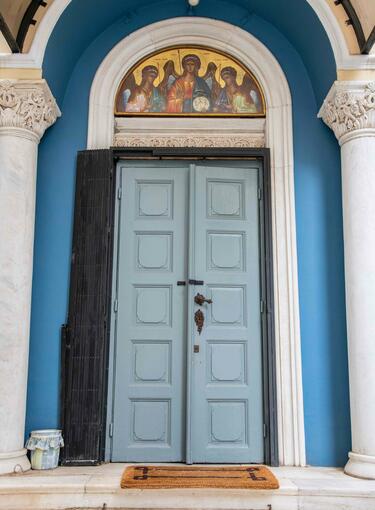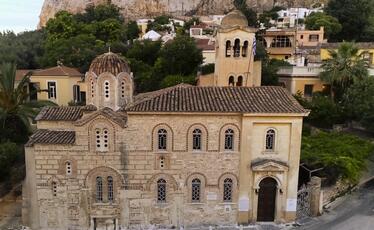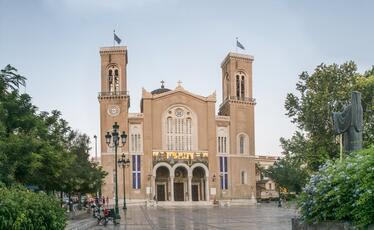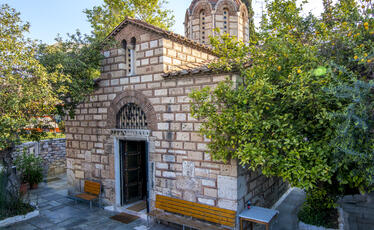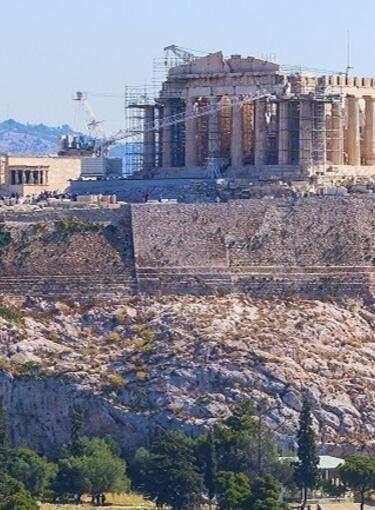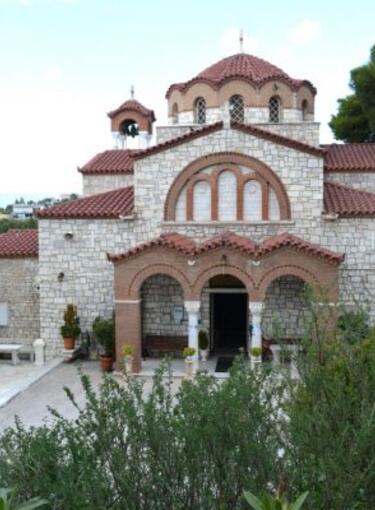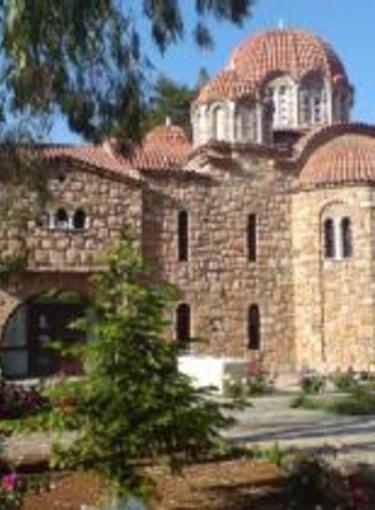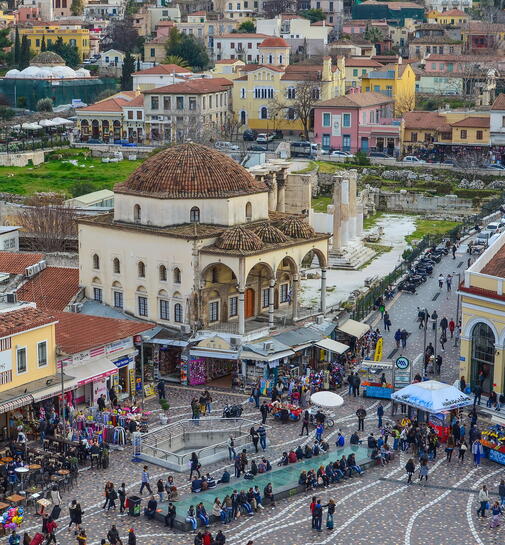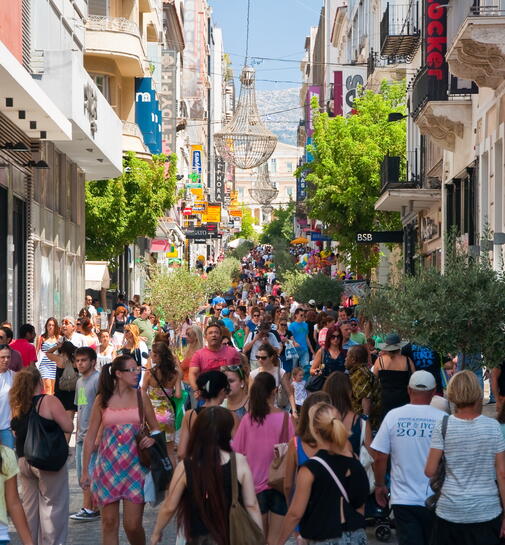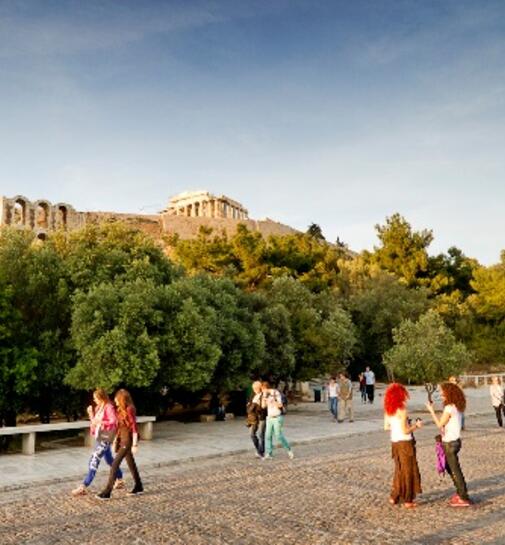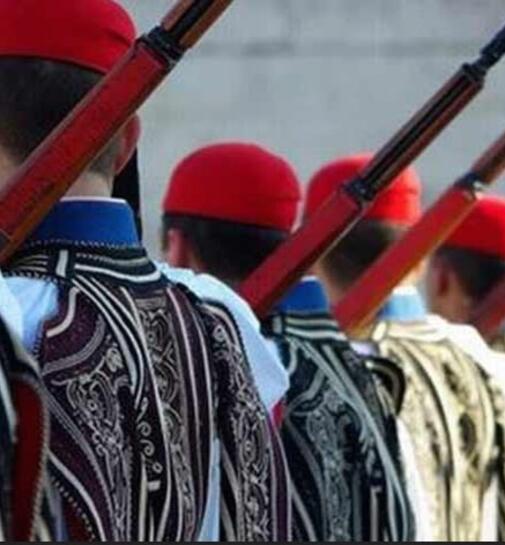At one of the busiest spots of Athens, at the Monastiraki square, is one of the oldest and lesser known churches in the city, dedicated to Panagia Pantanassa. Nowadays, it is pretty lower than the ground level due to the formation of the area around it, however in its initial form it dominated at this central area of the city.
The present day surviving church dates probably from the beginning of the 17th century and is built over an older monument. As we are informed by a patriarchal sigil of 1678, it was the catholicon of a women’s monastery, the metochi of the Monastery of Kaisariani, to which it was donated by Nikolaos Bonefatzis. In this period it was called Mega Monastiri (Large Monastery), however a few years later it declined and since 1821 the name Monastiraki prevailed and it was given to the wider area as well. In the year 1890, interventions were made to the monument and a stone bell tower was erected, which was later, in 1911, replaced by the present day one.
Architecturally the church belongs to the type of the three-aisled, vaulted basilica, whose middle aisle is roofed with a semi-circular vault, which on the east and west ends in conches with squinches. This way of roofing is an element of the Ottoman architecture and is applied to mosques and secular buildings already from the 15th century, having as a model the conches of Agia Sophia in Constantinople. The side aisles are roofed with cross-vaults. For the construction of the walls they have used abundant material from ancient buildings. The interior of the church is decorated with more recent wall paintings, while significant portable icons survive as well.
The church celebrates on the 15th of August.
Panagia Pantanassa (Church of Virgin Mary Most–Holy Queen of All)
At the centre of Athens, at Monastiraki, at the intersection of Ermou and Athinas Streets, precisely opposite to the METRO station, the pilgrim – tourist encounters the Church of Virgin Mary Pantanassa, a barrel-vaulted basilica, which has a great history and graces Monastiraki square. Having been erected between the 7th and 11th century, with the more probable version the one of the 10th century, it is included among the oldest churches of the city of Athens.
The name of the present district of Monastiraki originates from the wider area of the old Holy Monastery whose Katholikon was the Church in question.
The present state of the church alludes to the 16th – 17th centuries with the result that certain archaeologists and Byzantologists regard the churches as a post-Byzantine monument. Originally, Virgin Mary Pantanassa belonged to Lord Nikolaos Bonefantzis, which had in his possession all the buildings of the square resulting in the name ‘Mega Monastirio’ (Great Monastery). With the passage of time the church was converted into a convent and later on into a dependency of the Holy Monastery of Kesariani and subsequently into a parish church with the name ‘Monastiraki’ [Small Monastery].
Saint Luke the Younger of Mount Stirion (896-953) has linked his name with Panagia Pantanassa, as he was tonsured into monkhood at the original monastery, while in 1551 the Holy Martyr Philothei of Athens was tonsured as a nun by the Metropolitan of Athens Kallistos. Saint Nektarios served there as a deacon between the years 1881–1885. Saint Nikolaos Planas officiated in the church regularly, while therein deaconed as cantors Alexandros Papadiamantis and Alexandros Moraitidis.
The church, a barrel-vaulted three–aisled basilica of eastern style which one encounters in the eastern provinces of the Roman Empire, is distinctive and constitutes a real jewel for the district. Elements which render it distinctive is its construction with asymmetrical – irregular stones, among which are included also elements of early Christian churches and the presence of an immured ancient Greek capital in the four corners of the building. The conch at the eastern side is three–sided externally.
Despite that the damage which it sustained during the Revolution of 1821 modified its picture until then, the restoration and maintenance works of 1890 led to the erection of an elaborate and simultaneously majestic bell-tower, which unfortunately was wrecked in 1911. On its site stands the current voluminous bell-tower of inferior aesthetics. In the same year were added the narthex and the matroneum.
Upon entry into the three-aisled basilica, one observes that it is separated internally with piers and with the elevated middle barrel-vaulted aisle, namely semicircular. The two side aisles are covered with a pitched roof.
After the narthex the visitor encounters the significant sacred relics of Orthodoxy such as the holy icons of Saint Panteleimon which is dated in 1836 and Saint Thekla Agathoklia, who was honoured with a separate church at an adjacent street. At the right, the Bishop throne mesmerizes the eye, while the icon stands invite to prayer.
The murals of the nave, have been significantly defaced, owing to the damage of time and the overpaintings. In the four bays of the barrel-vault of the central nave one comes across easternly the Assumption of Theotokos, immediately thereafter the Pantokrator, at the next bay the Holy Spirit in the form of a pigeon, while westerly is depicted the Eye of God.
Impressive is also the marble ambo of the church, which is rich in artworks and remarkable carvings both at its apex and on the column on which it is based. Also, at the southern side under the cross–vaults of the side-aisles are depicted the Evangelists Mark and Saint George; at the north the other two evangelists with Saint Demetrius. In the four squinches are depicted the Plaques of the Law, the Holy Gospel, Jacob’s Ladder, Moses’ Burning Bush, the Ark of the Covenant and Aaron’s rod.
At the elaborate iconostasis of the church there are located unique elements of the art of icon painting, such as the miraculous icon of Virgin Mary of Tenderness (‘Panagia Eleousa’) and small icons with various depictions, works by the great icon painter Fotios Kontoglou. The details in the icon painting renders each icon the object of research and adoration, while in parallel they contribute to the formation of a sacramental atmosphere which calms the soul and creates spiritual elation.
Where however the visitor kneels with piety is before the icon of Saint Nektarios of Pentapoli. On its epigonation a piece of the holy relic of the Saint has been included, a fact which makes it a point of reference in the pilgrimage. Of special interest is the grand, modern large icon of Virgin Mary Gorgoepikoos [Virgin Mary listening speedily] of Athens, which has been crafted following the models of the corresponding icon which was found in Cairo, Egypt.
At the holy bema looms the Holy Altar of even mortar and with an ancient marble slab, which most probably originates either from Hadrian’s Library or from the Acropolis. Holy relics of Saint Barbara the Great Martyr, Agatha the Martyr, Irene the Great Martyr, Holy Macarius Notaras, Nikephoros of Chios and New Martyr Niketas of Nisyros are kept in elaborate reliquaries.
Informations
Additional
Date:
beginning of the 17th century
Season:
Post-Byzantine
Celebrates:
15 August
Holy Metropolis:
Archdiocese of Athens
Under the Supervision of:
Ephorate of Antiquities of Athens
Address:
Monastiraki Square, Monastiraki
Access:
Metro Monastiraki


